Environmental Impacts of Nitrogen and Phosphorus Nutrient Diffusion Fluxes at a Sediment-Water Interface: The Case of the Yitong River, China
Abstract
1. Introduction
2. Materials and Methods
2.1. Placement of Sampling Sites
2.2. Sample Collection and Testing Methods
2.3. Simulation Experimental Program
2.4. Calculation Method for Nitrogen and Phosphorus Release Fluxes
2.4.1. Calculation Method for Nitrogen and Phosphorus Quantities in the Yitong River
2.4.2. Nitrogen and Phosphorus Flux Calculation Method for Simulation Experiments
3. Results and Discussion
3.1. Overlying Water—Interstitial Water Quality Characteristics
3.2. Analysis of Sediment Nitrogen and Phosphorus Release Fluxes
3.3. Effects of Environmental Factors on Nitrogen and Phosphorus Release
3.3.1. Influence of Environmental Factors on Nitrogen and Phosphorus Release
3.3.2. Effect of pH on the Release of Nitrogen and Phosphorus
3.3.3. Effect of Dissolved Oxygen on Nitrogen and Phosphorus Release
4. Conclusions
Author Contributions
Funding
Conflicts of Interest
References
- Huisman, J.; Codd, G.A.; Paerl, H.W.; Ibelings, B.W.; Verspagen, J.M.; Visser, P.M. Cyanobacterial blooms. Nat. Rev. Microbiol. 2018, 16, 471–483. [Google Scholar] [CrossRef] [PubMed]
- Chen, Q.; Chen, J.; Wang, J.; Guo, J.; Jin, Z.; Yu, P.; Ma, Z. In situ, high-resolution evidence of phosphorus release from sediments controlled by the reductive dissolution of iron-bound phosphorus in a deep reservoir, southwestern China. Sci. Total Environ. 2019, 666, 39–45. [Google Scholar] [CrossRef] [PubMed]
- Huang, L.; Fang, H.; Reible, D. Mathematical model for interactions and transport of phosphorus and sediment in the Three Gorges Reservoir. Water Res. 2015, 85, 393–403. [Google Scholar] [CrossRef]
- Paytan, A.; Roberts, K.; Watson, S.; Peek, S.; Chuang, P.C.; Defforey, D.; Kendall, C. Internal loading of phosphate in lake erie central basin. Sci. Total Environ. 2017, 579, 1356–1365. [Google Scholar] [CrossRef] [PubMed]
- Schindler, D.W.; Carpenter, S.R.; Chapra, S.C.; Hecky, R.E.; Orihel, D.M. Reducing phosphorus to curb lake eutrophication is a success. Environ. Sci. Technol. 2016, 50, 8923–8929. [Google Scholar] [CrossRef]
- Abdi, R.; Endreny, T.; Nowak, D. A model to integrate urban river thermal cooling in river restoration. J. Environ. Manag. 2020, 258, 110023. [Google Scholar] [CrossRef] [PubMed]
- Pereda, O.; von Schiller, D.; Garcia-Baquero, G.; Mor, J.R.; Acuna, V.; Sabater, S.; Elosegi, A. Combined effects of urban pollution and hydrological stress on ecosystem functions of Mediterranean streams. Sci. Total Environ. 2021, 753, 141971. [Google Scholar] [CrossRef] [PubMed]
- Zhang, P.; Cao, C.; Wang, Y.H.; Yu, K.; Liu, C.; He, C.; Wang, J.J. Chemodiversity of water-extractable organic matter in sediment columns of a polluted urban river in South China. Sci. Total Environ. 2021, 777, 146127. [Google Scholar] [CrossRef]
- Jarvie, H.P.; Lycett, E.; Neal, C.; Love, A. Patterns in nutrient concentrations and biological quality indices across the upper Thames river basin, UK. Sci. Total Environ. 2002, 282, 263–294. [Google Scholar] [CrossRef]
- Maslukah, L.; Wulandari, S.Y.; Prasetyawan, I.B.; Zainuri, M. Distributions and Fluxes of Nitrogen and Phosphorus Nutrients in Porewater Sediments in the Estuary of Jepara Indonesia. J. Ecol. Eng. 2019, 20, 58–64. [Google Scholar] [CrossRef]
- Lei, P.; Zhang, H.; Wang, C.; Pan, K. Migration and diffusion for pollutants across the sediment-water interface in lakes: A review. J. Lake Sci. 2018, 30, 1489–1508. [Google Scholar] [CrossRef]
- Wu, Z.; Liu, Y.; Liang, Z.; Wu, S.; Guo, H. Internal cycling, not external loading, decides the nutrient limitation in eutrophic lake: A dynamic model with temporal Bayesian hierarchical inference. Water Res. 2017, 116, 231–240. [Google Scholar] [CrossRef] [PubMed]
- Kuypers, M.M.; Marchant, H.K.; Kartal, B. The microbial nitrogen-cycling network. Nat. Rev. Microbiol. 2018, 16, 263–276. [Google Scholar] [CrossRef]
- Gibbons, K.J.; Bridgeman, T.B. Effect of temperature on phosphorus flux from anoxic western Lake Erie sediments. Water Res. 2020, 182, 116022. [Google Scholar] [CrossRef] [PubMed]
- Aminot, A.; Andrieux, F. Concept and determination of exchangeable phosphate in aquatic sediments. Water Res. 1996, 30, 2805–2811. [Google Scholar] [CrossRef]
- Kaiser, D.; Unger, D.; Qiu, G.; Zhou, H.; Gan, H. Natural and human influences on nutrient transport through a small subtropical Chinese estuary. Sci. Total Environ. 2013, 450, 92–107. [Google Scholar] [CrossRef]
- Ferencz, B.; Toporowska, M.; Dawidek, J.; Sobolewski, W. Hydro-Chemical Conditions of Shaping the Water Quality of Shallow Łęczna-Włodawa Lakes (Eastern Poland). CLEAN–Soil Air Water 2017, 45, 1600152. [Google Scholar] [CrossRef]
- Alwan, G. Adaptive genetic PH control of a wastewater treatment unit via LAB View. Chem. Process Eng. Res. 2012, 5, 22–31. Available online: https://www.researchgate.net/publication/320191101_Adaptive_Genetic_pH_Control_of_a_Wastewater_Treatment_Unit_via_LAB_View (accessed on 24 August 2022).
- Cerco, C.F. Measured and modelled effects of temperature, dissolved oxygen and nutrient concentration on sediment-water nutrient exchange. Hydrobiologia 1989, 174, 185–194. [Google Scholar] [CrossRef]
- Kieskamp, W.M.; Lohse, L.; Epping, E.; Helder, W. Seasonal variation in denitrification rates and nitrous oxide fluxes in intertidal sediments of the western Wadden Sea. Marine ecology progress series. Oldendorf 1991, 72, 145–151. [Google Scholar] [CrossRef]
- Anthony, J.L.; Lewis, W.M. Low boundary layer response and temperature dependence of nitrogen and phosphorus releases from oxic sediments of an oligotrophic lake. Aquat. Sci. 2012, 74, 611–617. [Google Scholar] [CrossRef]
- Ator, S.W.; García, A.M.; Schwarz, G.E.; Blomquist, J.D.; Sekellick, A.J. Toward explaining nitrogen and phosphorus trends in Chesapeake Bay tributaries, 1992–2012. JAWRA J. Am. Water Resour. Assoc. 2019, 55, 1149–1168. [Google Scholar] [CrossRef]
- Berezina, N.A.; Maximov, A.A.; Vladimirova, O.M. Influence of benthic invertebrates on phosphorus flux at the sediment-water interface in the easternmost Baltic Sea. Mar. Ecol. Prog. Ser. 2019, 608, 33–43. [Google Scholar] [CrossRef]
- Spears, B.M.; Carvalho, L.; Perkins, R.; Paterson, D.M. Effects of light on sediment nutrient flux and water column nutrient stoichiometry in a shallow lake. Water Res. 2008, 42, 977–986. [Google Scholar] [CrossRef]
- Thomann, R.V.; Mueller, J.A. Principles of Surface Water Quality Modeling and Control; Harper & Row Publishers: New York, NY, USA, 1987; Available online: http://hdl.handle.net/1969.3/24446 (accessed on 24 August 2022).
- Al-Bahry, S.N.; Mahmoud, I.Y.; Al-Musharafi, S.K. The effect of physical factors on fecal coliform viability rate in sewage sludge. J. Geosci. Environ. Prot. 2014, 2, 9. [Google Scholar] [CrossRef]
- Cline, J.D. Spectrophotometric determination of hydrogen sulfide in natural waters 1. Limnol. Oceanogr. 1969, 14, 454–458. [Google Scholar] [CrossRef]
- Martinova, M.V. Nitrogen and phosphor compounds in bottom sediments: Mechanisms of accumulation, transformation and release. Hydrobiologia 1993, 252, 1–22. [Google Scholar] [CrossRef]
- Sweerts, J.P.R.; Bär-Gilissen, M.J.; Cornelese, A.A.; Cappenberg, T.E. Oxygen-consuming processes at the profundal and littoral sediment-water interface of a small meso-eutrophic lake (Lake Vechten, The Netherlands). Limnol. Oceanogr. 1991, 36, 1124–1133. [Google Scholar] [CrossRef]
- Ullman, W.J.; Sandstrom, M.W. Dissolved nutrient fluxes from the nearshore sediments of Bowling Green Bay, central Great Barrier Reef lagoon (Australia). Estuar. Coast. Shelf Sci. 1987, 24, 289–303. [Google Scholar] [CrossRef]
- Urban, N.R.; Dinkel, C.; Wehrli, B. Solute transfer across the sediment surface of a eutrophic lake: I. Porewater profiles from dialysis samplers. Aquat. Sci. 1997, 59, 1–25. [Google Scholar] [CrossRef]
- Berner, R.A. Early Diagenesis: A Theoretical Approach (No. 1); Princeton University Press: Princeton, NJ, USA, 1980. [Google Scholar]
- Li, N.X.; Xu, J.F.; Yin, W.; Chen, Q.Z.; Wang, J.; Shi, Z.H. Effect of local watershed landscapes on the nitrogen and phosphorus concentrations in the waterbodies of reservoir bays. Sci. Total Environ. 2020, 716, 137132. [Google Scholar] [CrossRef] [PubMed]
- Danyang, W.; Xianqiang, T.; Rui, L.; Wenjun, Y. Spatial distribution patterns of nitrogen and phosphorus in water and bed sediment of the Three Gorges Reservoir. J. Clean. Prod. 2021, 322, 129026. [Google Scholar] [CrossRef]
- Chen, S.S.; Kimirei, I.A.; Yu, C.; Shen, Q.; Gao, Q. Assessment of urban river water pollution with urbanization in East Africa. Environ. Sci. Pollut. Res. 2022, 29, 40812–40825. [Google Scholar] [CrossRef] [PubMed]
- Haghnazar, H.; Cunningham, J.A.; Kumar, V.; Aghayani, E.; Mehraein, M. COVID-19 and urban rivers: Effects of lockdown period on surface water pollution and quality-a case study of the Zarjoub River, north of Iran. Environ. Sci. Pollut. Res. 2022, 29, 27382–27398. [Google Scholar] [CrossRef] [PubMed]
- de Klein, J.J.; Overbeek, C.C.; Juncher Jørgensen, C.; Veraart, A.J. Effect of temperature on oxygen profiles and denitrification rates in freshwater sediments. Wetlands 2017, 37, 975–983. [Google Scholar] [CrossRef]
- Zhong, J.; Wen, S.; Zhang, L.; Wang, J.; Liu, C.; Yu, J.; Zhang, L.; Fan, C. Nitrogen budget at sediment–water interface altered by sediment dredging and settling particles: Benefits and drawbacks in managing eutrophication. J. Hazard. Mater. 2021, 406, 124691. [Google Scholar] [CrossRef]
- Zhong, W.; Wang, S.; Dong, Y.; Ni, Z.; Fan, Y.; Wu, D. Trends of the response-relationship between net anthropogenic nitrogen and phosphorus inputs (NANI/NAPI) and TN/TP export fluxes in Raohe basin, China. Chemosphere 2022, 286, 131662. [Google Scholar] [CrossRef]
- Liikanen, A.N.U.; Murtoniemi, T.; Tanskanen, H.; Väisänen, T.; Martikainen, P.J. Effects of temperature and oxygenavailability on greenhouse gas and nutrient dynamics in sediment of a eutrophic mid-boreal lake. Biogeochemistry 2002, 59, 269–286. [Google Scholar] [CrossRef]
- Zhao, H.; Zhang, L.; Wang, S.; Jiao, L. Features and influencing factors of nitrogen and phosphorus diffusive fluxes at the sediment-water interface of Erhai Lake. Environ. Sci. Pollut. Res. 2018, 25, 1933–1942. [Google Scholar] [CrossRef]
- Matos, C.R.; Berrêdo, J.F.; Machado, W.; Metzger, E.; Sanders, C.J.; Faial, K.C.; Cohen, M.C. Seasonal changes in metal and nutrient fluxes across the sediment-water interface in tropical mangrove creeks in the Amazon region. Appl. Geochem. 2022, 138, 105217. [Google Scholar] [CrossRef]
- Liu, X.; Beusen, A.H.; Van Beek, L.P.; Mogollón, J.M.; Ran, X.; Bouwman, A.F. Exploring spatiotemporal changes of the Yangtze River (Changjiang) nitrogen and phosphorus sources, retention and export to the East China Sea and Yellow Sea. Water Res. 2018, 142, 246–255. [Google Scholar] [CrossRef] [PubMed]
- Chen, M.; Ding, S.; Chen, X.; Sun, Q.; Fan, X.; Lin, J.; Ren, M.; Yang, L.; Zhang, C. Mechanisms driving phosphorus release during algal blooms based on hourly changes in iron and phosphorus concentrations in sediments. Water Res. 2018, 133, 153–164. [Google Scholar] [CrossRef] [PubMed]
- Azzoni, R.; Giordani, G.; Bartoli, M.; Welsh, D.T.; Viaroli, P. Iron, sulphur and phosphorus cycling in the rhizosphere sediments of a eutrophic Ruppia cirrhosa meadow (Valle Smarlacca, Italy). J. Sea Res. 2001, 45, 15–26. [Google Scholar] [CrossRef]
- Zhang, L.; Wang, S.; Wu, Z. Coupling effect of pH and dissolved oxygen in water column on nitrogen release at water–sediment interface of Erhai Lake, China. Estuarine, Coastal and Shelf Science 2014, 149, 178–186. [Google Scholar] [CrossRef]
- Zhang, Y.; Liu, Z.; Zhang, Y.; He, F.; Wu, Z. Effects of varying environmental conditions on release of sediment phosphorus in West Lake, Hang Zhou, China. Acta Hydrobiol. Sin. 2017, 41, 1354–1361. [Google Scholar] [CrossRef]
- Gaoa, L. Phosphorus release from the sediments in Rongcheng Swan Lake under different pH conditions. Procedia Environ. Sci. 2012, 13, 2077–2084. [Google Scholar] [CrossRef]
- Wang, J.; Chen, J.; Yu, P.; Yang, X.; Zhang, L.; Geng, Z.; He, K. Oxygenation and synchronous control of nitrogen and phosphorus release at the sediment-water interface using oxygen nano-bubble modified material. Sci. Total Environ. 2020, 725, 138258. [Google Scholar] [CrossRef]
- Meiyan, L.A.N.; Yonggui, W.U.; Youfa, L.U.O.; Jianye, W.U.; Xiaorui, W.A.N.G.; Zile, P.E.N.G. Oxygen environment changes on carbon, nitrogen, and phosphorus release and bacterial community of land-based recirculating aquaculture fish manure. Chin. J. Environ. Eng. 2022, 16, 2740–2753. [Google Scholar] [CrossRef]
- Li, H.; Song, C.L.; Cao, X.Y.; Zhou, Y.Y. The phosphorus release pathways and their mechanisms driven by organic carbon and nitrogen in sediments of eutrophic shallow lakes. Sci. Total Environ. 2016, 572, 280–288. [Google Scholar] [CrossRef]
- Beutel, M.W.; Leonard, T.M.; Dent, S.R.; Moore, B.C. Effects of aerobic and anaerobic conditions on P, N, Fe, Mn, and Hg accumulation in waters overlaying profundal sediments of an oligo-mesotrophic lake. Water Res. 2008, 42, 1953–1962. [Google Scholar] [CrossRef]
- Kang, M.; Peng, S.; Tian, Y.; Zhang, H. Effects of dissolved oxygen and nutrient loading on phosphorus fluxes at the sediment–water interface in the Hai River Estuary, China. Mar. Pollut. Bull. 2018, 130, 132–139. [Google Scholar] [CrossRef] [PubMed]
- Zhang, Y.; He, F.; Liu, Z.; Liu, B.; Zhou, Q.; Wu, Z. Release characteristics of sediment phosphorus in all fractions of West Lake, Hang Zhou, China. Ecol. Eng. 2016, 95, 645–651. [Google Scholar] [CrossRef]
- Matisoff, G.; Kaltenberg, E.M.; Steely, R.L.; Hummel, S.K.; Seo, J.; Gibbons, K.J.; Chaffin, J.D. Internal loading of phosphorus in western Lake Erie. J. Great Lakes Res. 2016, 42, 775–788. [Google Scholar] [CrossRef]
- Ahlgren, J.; Reitzel, K.; De Brabandere, H.; Gogoll, A.; Rydin, E. Release of organic P forms from lake sediments. Water Res. 2011, 45, 565–572. [Google Scholar] [CrossRef]

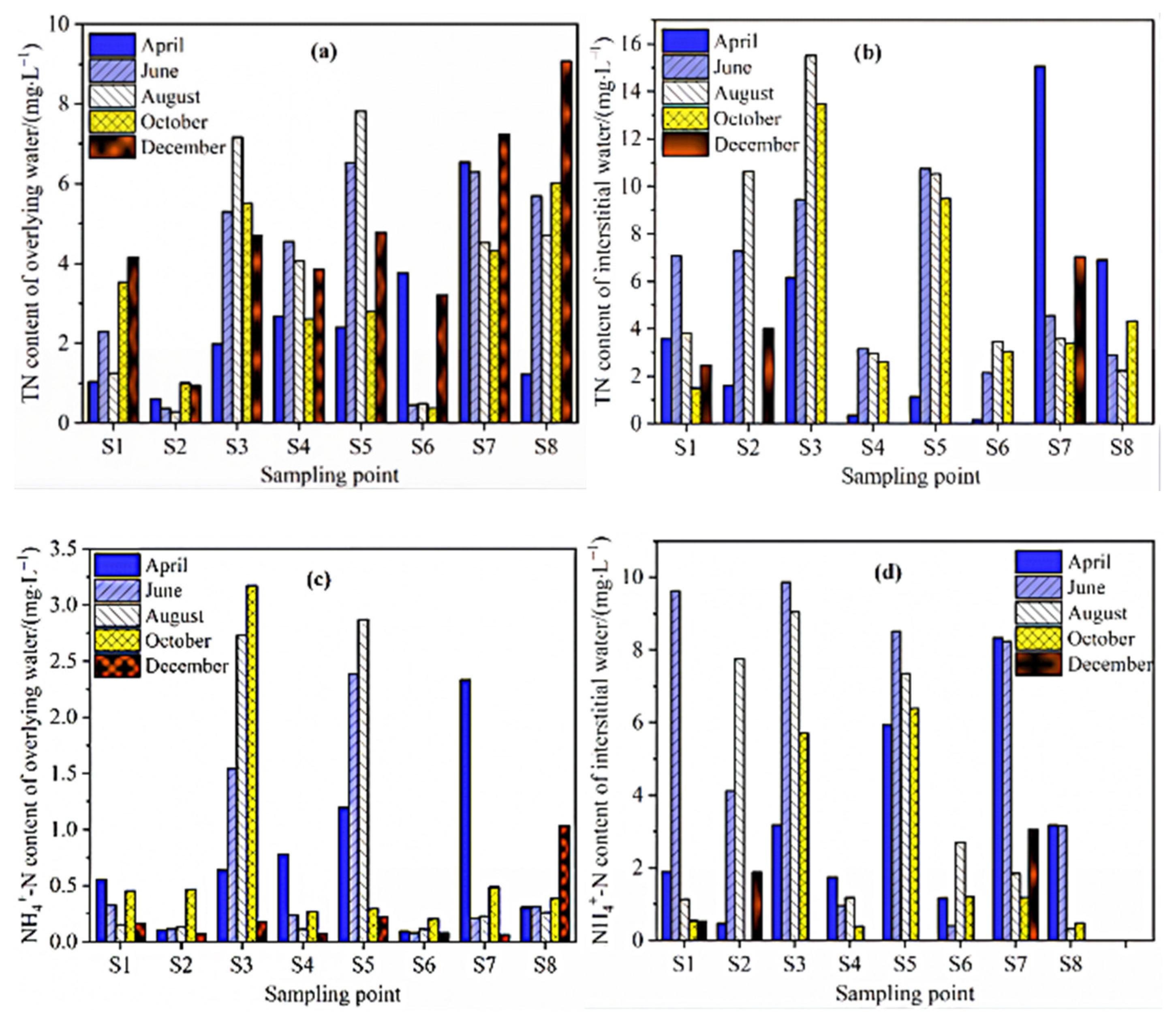
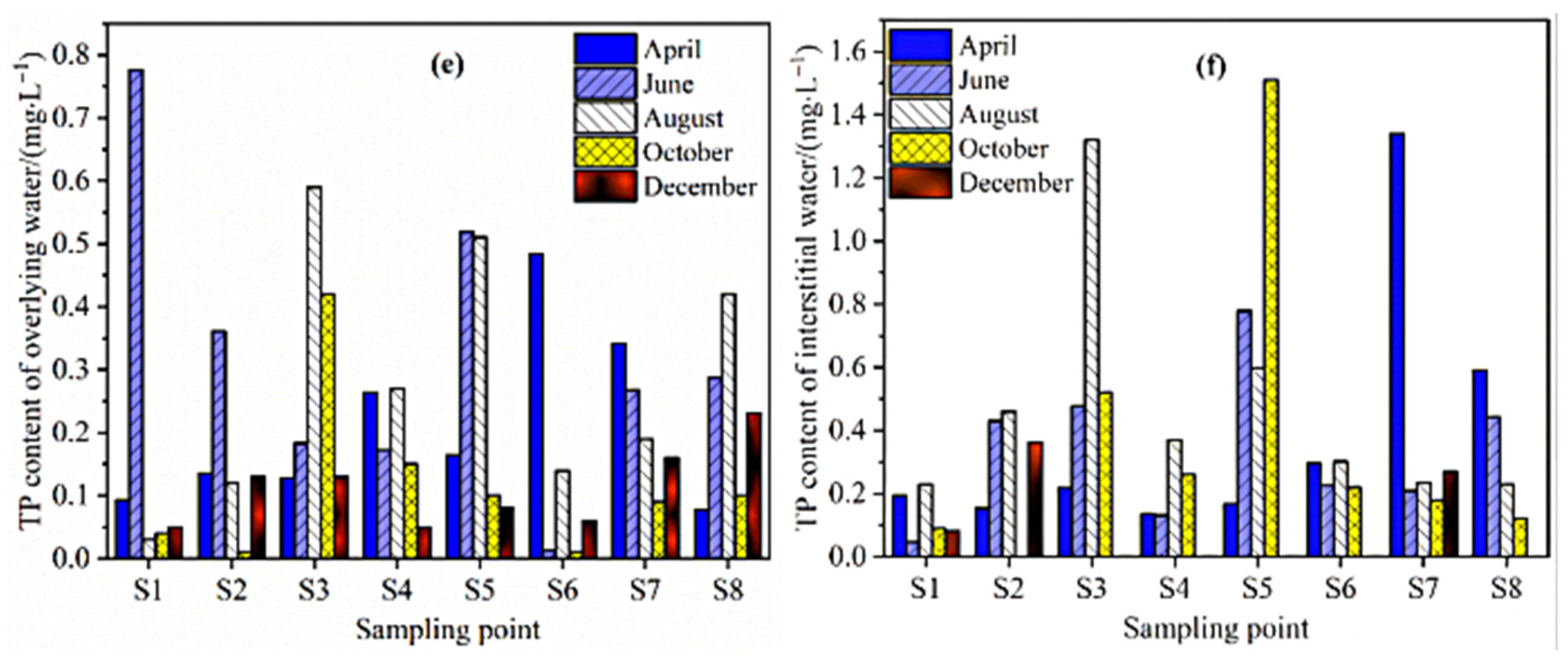

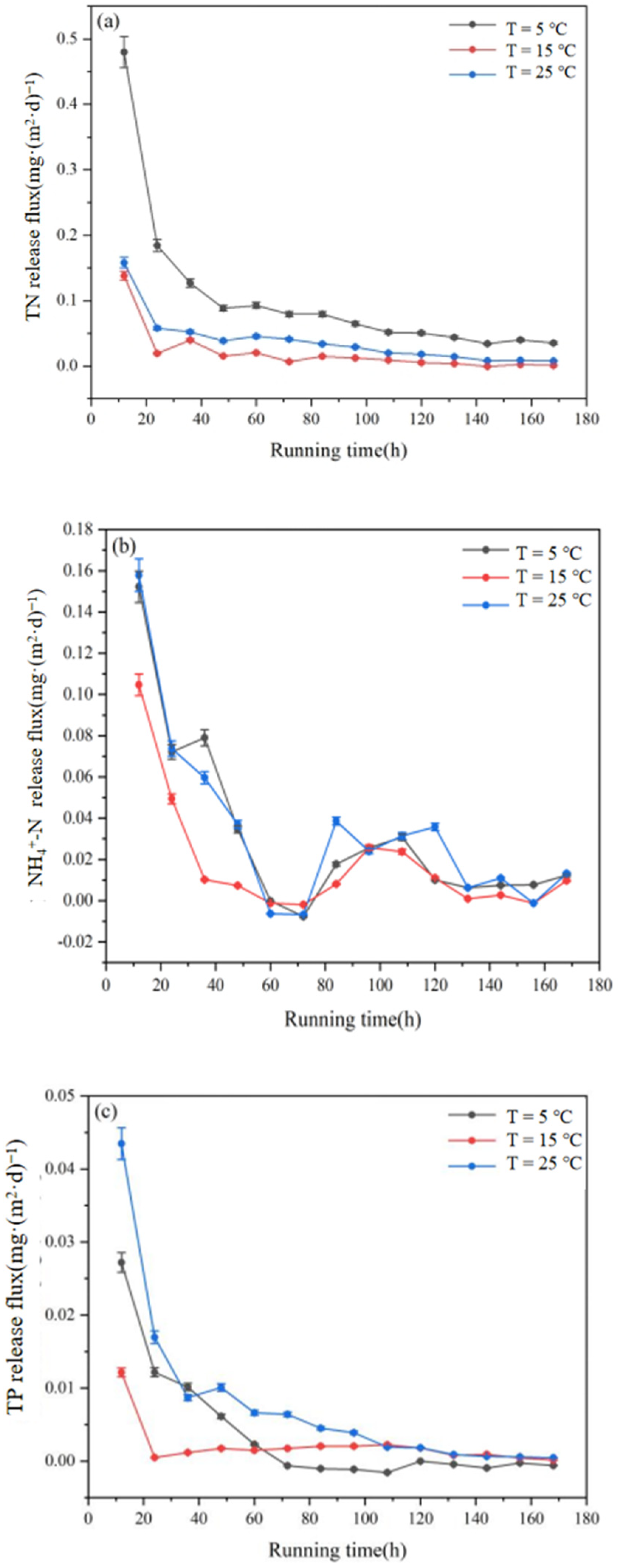
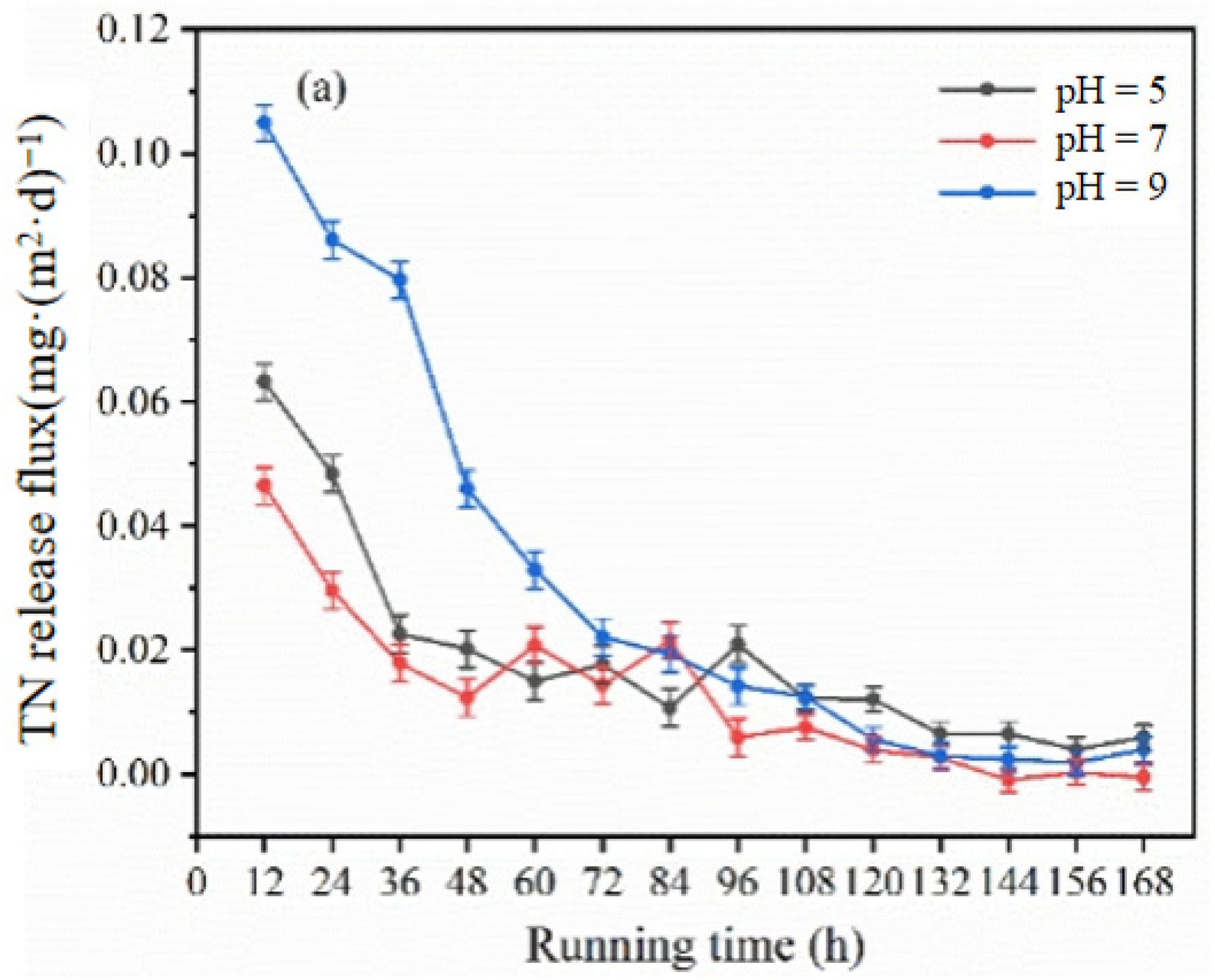
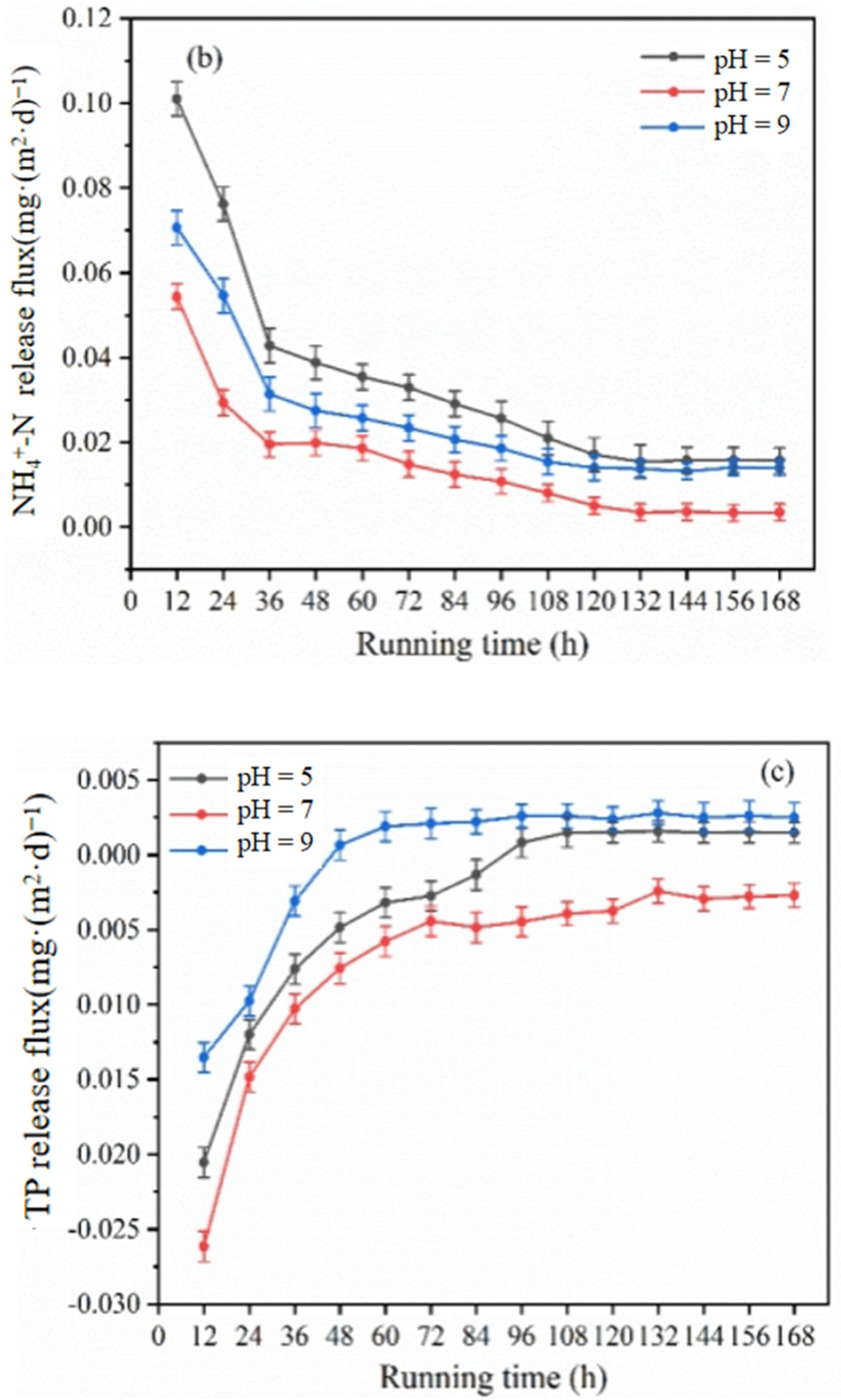
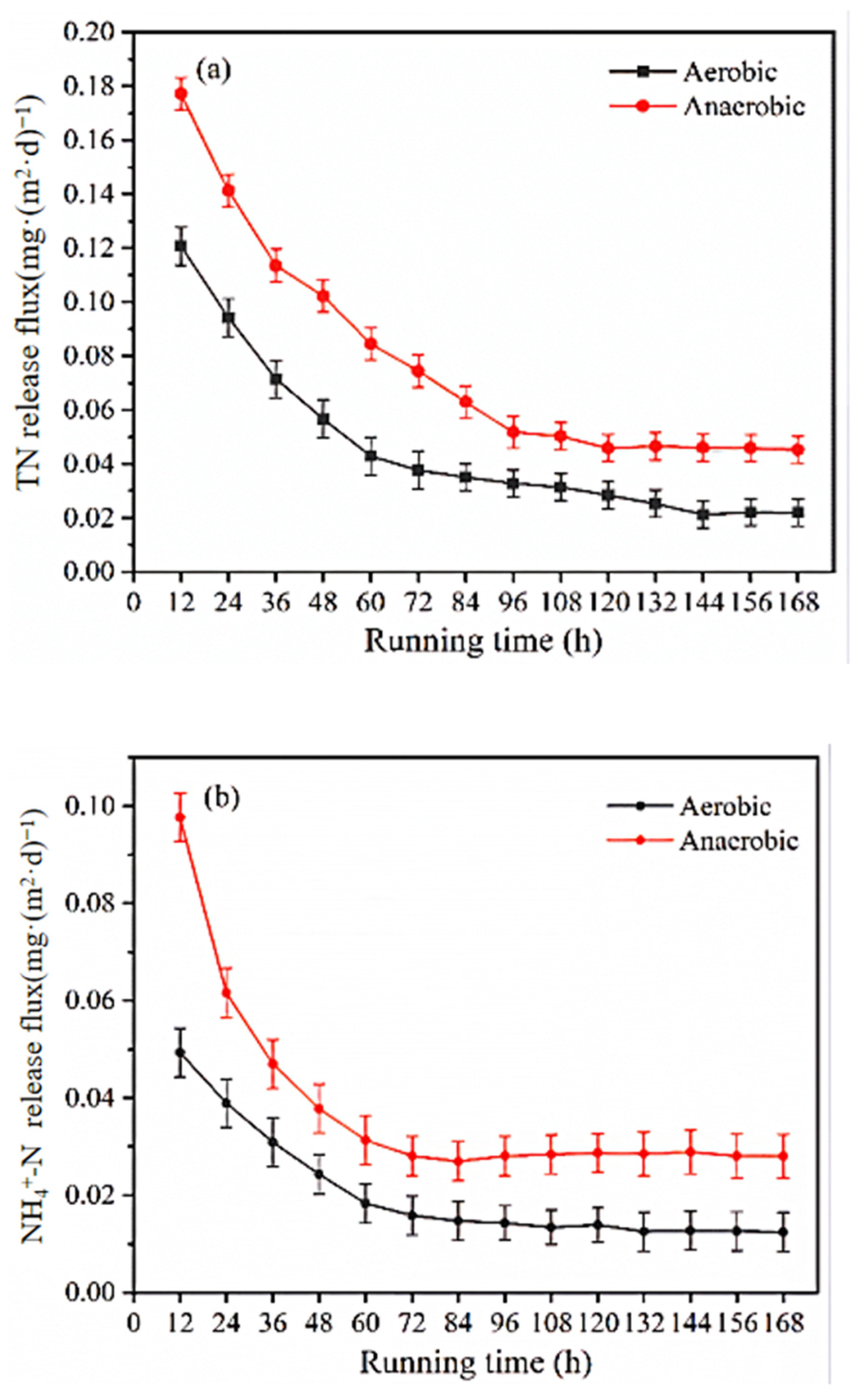
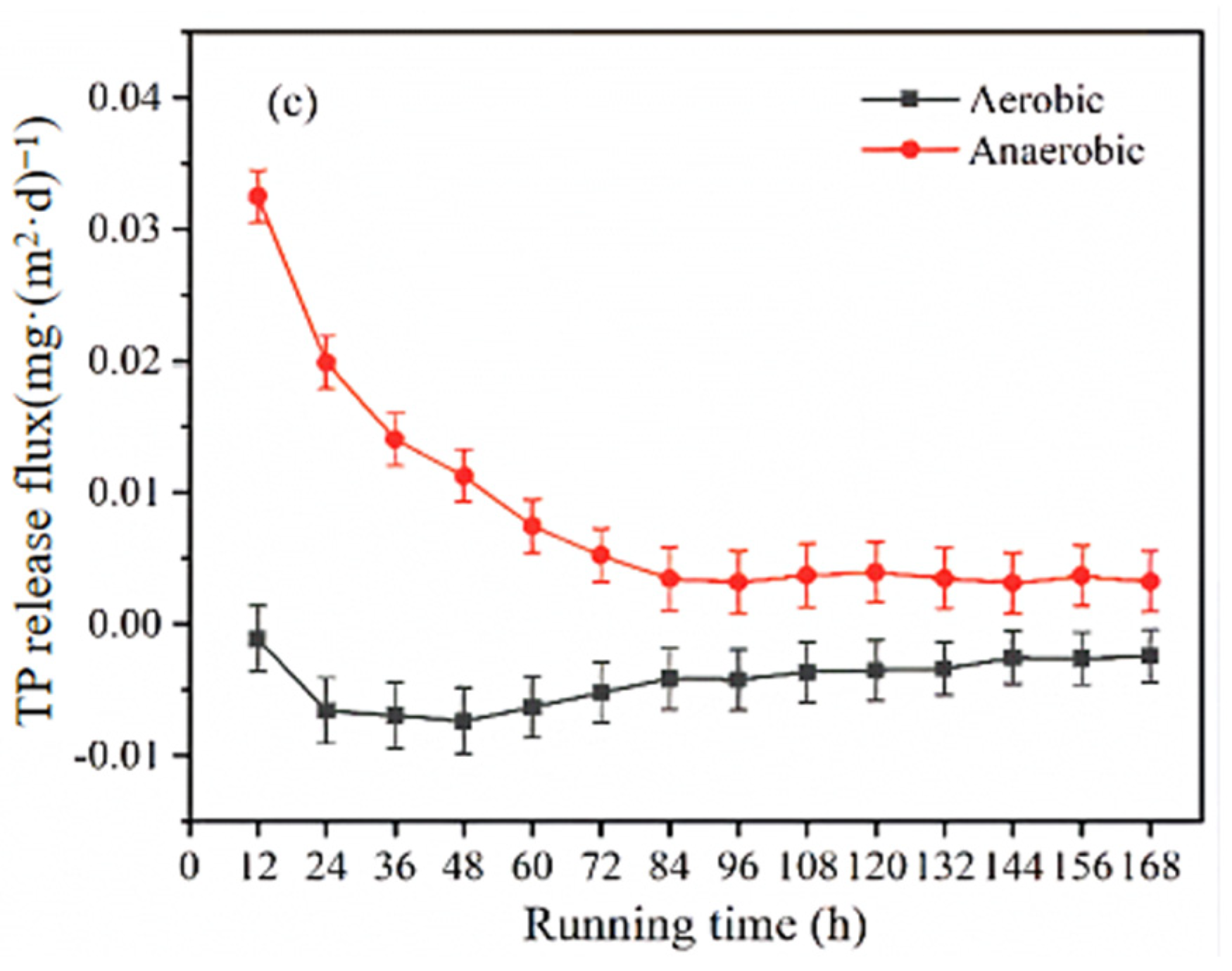
| Nutritional Salts | Points | April | June | August | October | December |
|---|---|---|---|---|---|---|
| TN | S1 | 2.398 ± 0.281 | 2.381 ± 0.241 | 1.813 ± 0.194 | -0.878 ± 0.009 | −0.661± 0.051 |
| S2 | 1.477 ± 0.181 | 4.001 ± 0.372 | 6.075 ± 0.302 | 16.239 ± 1.324 | 3.391 ± 0.296 | |
| S3 | 2.213 ± 0.246 | 4.681 ± 0.391 | 11.593 ± 0.719 | −0.004 ± 0.001 | — | |
| S4 | 0.596 ± 0.076 | −0.087 ± 0.010 | −0.646 ± 0.077 | 11.311 ± 0.994 | — | |
| S5 | 9.120 ± 0.995 | 5.823 ± 0.613 | 1.697 ± 0.185 | 1.317 ± 0.085 | — | |
| S6 | −2.177 ± 0.213 | 1.021 ± 0.122 | 1.667 ± 0.153 | −0.418 ± 0.037 | — | |
| S7 | 19.365 ± 2.143 | −0.500 ± 0.061 | −0.398 ± 0.033 | −0.729 ± 0.052 | 0.119 ± 0.010 | |
| S8 | 5.082 ± 0.521 | −1.495 ± 0.179 | −1.571 ± 0.104 | −0.878 ± 0.079 | — | |
| NH4+-N | S1 | 0.821 ± 0.093 | 3.146 ± 0.177 | 0.486 ± 0.025 | 0.026 ± 0.002 | 0.119 ± 0.009 |
| S2 | 0.075 ± 0.016 | 1.685 ± 0.159 | 3.991 ± 0.381 | 1.423 ± 0.101 | 1.100 ± 0.095 | |
| S3 | 1.843 ± 0.203 | 3.613 ± 0.318 | 6.517 ± 0.529 | 0.101 ± 0.074 | — | |
| S4 | 0.296 ± 0.332 | 0.445 ± 0.036 | 0.43 ± 0.048 | 7.098 ± 0.517 | — | |
| S5 | 4.031 ± 0.398 | 2.827 ± 0.311 | 1.948 ± 0.205 | 0.339 ± 0.031 | — | |
| S6 | −0.171 ± 0.028 | 0.095 ± 0.011 | 0.998 ± 0.106 | 0.216 ± 0.019 | — | |
| S7 | 9.227 ± 1.072 | 3.631 ± 0.257 | 0.473 ± 0.037 | 0.025 ± 0.002 | 1.835 ± 0.175 | |
| S8 | 2.272 ± 0.219 | 2.599 ± 0.176 | 0.025 ± 0.003 | 0.026 ± 0.003 | — | |
| TP | S1 | 0.033 ± 0.003 | 0.002 ± 0.001 | 0.062 ± 0.005 | 0.009 ± 0.001 | 0.016 ± 0.001 |
| S2 | 0.031 ± 0.002 | 0.103 ± 0.009 | 0.113 ± 0.011 | 0.034 ± 0.002 | 0.121 ± 0.011 | |
| S3 | 0.051 ± 0.006 | 0.141± 0.013 | 0.223 ± 0.019 | 0.059 ± 0.005 | — | |
| S4 | 0.019 ± 0.002 | 0.03 ± 0.002 | 0.024 ± 0.002 | 1.020 ± 0.089 | — | |
| S5 | 0.055 ± 0.006 | 0.230 ± 0.017 | 0.025 ± 0.002 | 0.048 ± 0.005 | — | |
| S6 | 0.058 ± 0.005 | 0.050 ± 0.006 | 0.039 ± 0.003 | 0.018 ± 0.002 | — | |
| S7 | 0.595 ± 0.071 | 0.001 ± 0.000 | 0.009 ± 0.001 | 0.004 ± 0.000 | 0.085 ± 0.010 | |
| S8 | 0.127 ± 0.015 | 0.144 ± 0.012 | −0.052 ± 0.005 | 0.009 ± 0.001 | — |
Disclaimer/Publisher’s Note: The statements, opinions and data contained in all publications are solely those of the individual author(s) and contributor(s) and not of MDPI and/or the editor(s). MDPI and/or the editor(s) disclaim responsibility for any injury to people or property resulting from any ideas, methods, instructions or products referred to in the content. |
© 2023 by the authors. Licensee MDPI, Basel, Switzerland. This article is an open access article distributed under the terms and conditions of the Creative Commons Attribution (CC BY) license (https://creativecommons.org/licenses/by/4.0/).
Share and Cite
Zhao, K.; Fu, H.; Zhu, Y.; Wang, Y.; Wang, S.; Li, F. Environmental Impacts of Nitrogen and Phosphorus Nutrient Diffusion Fluxes at a Sediment-Water Interface: The Case of the Yitong River, China. Sustainability 2023, 15, 1210. https://doi.org/10.3390/su15021210
Zhao K, Fu H, Zhu Y, Wang Y, Wang S, Li F. Environmental Impacts of Nitrogen and Phosphorus Nutrient Diffusion Fluxes at a Sediment-Water Interface: The Case of the Yitong River, China. Sustainability. 2023; 15(2):1210. https://doi.org/10.3390/su15021210
Chicago/Turabian StyleZhao, Ke, Hang Fu, Yinze Zhu, Yue Wang, Shuwei Wang, and Fengxiang Li. 2023. "Environmental Impacts of Nitrogen and Phosphorus Nutrient Diffusion Fluxes at a Sediment-Water Interface: The Case of the Yitong River, China" Sustainability 15, no. 2: 1210. https://doi.org/10.3390/su15021210
APA StyleZhao, K., Fu, H., Zhu, Y., Wang, Y., Wang, S., & Li, F. (2023). Environmental Impacts of Nitrogen and Phosphorus Nutrient Diffusion Fluxes at a Sediment-Water Interface: The Case of the Yitong River, China. Sustainability, 15(2), 1210. https://doi.org/10.3390/su15021210





